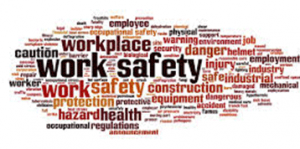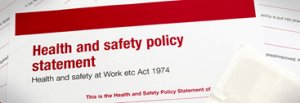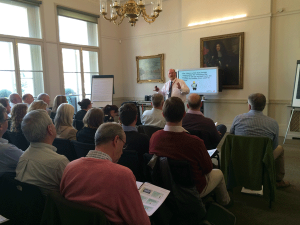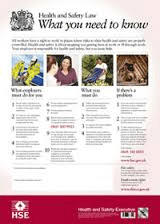I often get people saying to me
“It’s all very well for you to talk about health & Safety, but it is far too complicated and I haven’t got the time to deal with it”.
Managing health and safety doesn’t have to be complicated, costly or time consuming.
For many businesses, all that’s required is a basic series of practical tasks that protect people from harm and at the same time protect the future success and the growth of your business. So this week I will take you through the steps and help you make sure you have done what you need to – and no more.
We also have 2 recent HSE cases for you to look at and think about:
- A wood waste company was sentenced today for safety breaches after a worker was killed when he fell four metres from a walking floor trailer in South Yorkshire while manually un-sheeting the unit.
- A recycling company has been fined £880,000, and two people have been given suspended prison sentenced after the death of an agency worker who was drawn into machinery while cleaning in the area.
We hope you learn from the mistakes of others that are highlighted in our weekly newsletters and, as a result, do not have similar accidents at your workplace.
As ever, if you have a subject that you would like us to cover one week, please contact us by phone 01458 253682 email or via our Facebook page or by Twitter
Health and Safety made Simple
 In general, health and safety laws apply to all businesses. As an employer, or a self-employed person, you are responsible for health and safety in your business. Health and safety laws are there to protect you, your employees and the public from workplace dangers.
In general, health and safety laws apply to all businesses. As an employer, or a self-employed person, you are responsible for health and safety in your business. Health and safety laws are there to protect you, your employees and the public from workplace dangers.
The approach you take should be proportionate to the size of your business and the nature of your business activity. For most small, low-risk businesses the steps you need to take are straightforward. If you have fewer than five employees you don’t have to write down your risk assessment or your health and safety policy.
You need to ensure that you have the right help
As an employer, you must appoint someone competent to help you meet your health and safety duties. A competent person is someone with the necessary skills, knowledge and experience to manage health and safety.
If you run a low-risk business, health and safety is something you can manage without needing to buy in expert help. Here you could appoint yourself as a competent person or one or more of your workers.
However, if you are not confident of your ability to manage all health and safety in-house, or if you are a higher-risk business, you may need some external help or advice.
Write a health and safety policy for your business
Describing how you will manage health and safety in your business will let your staff and others know about your commitment to health and safety. This will be your health and safety policy. It should clearly say who does what, when and how.
If you have fewer than five employees you don’t have to write down your health and safety policy.
The policy does not need to be complicated or time-consuming. It comes in three sections:
- General Statement – This is meant to show your commitment to providing your workforce with a safe and healthy place of work
- Organisation – This section explains the make-up of the company and details the responsibility towards health and safety, of everybody in the company from the Owner/MD down to the most junior worker. Nobody should be able to say “I didn’t know I was responsible for that”.
- Arrangements – This section is the real crux of the policy and spells out how you, as an organisation, expect your staff to meet standards and what controls or procedures to follow. For example: Your policy on Drink and Drugs is… What is your policy regarding noise at work, hazardous substances or driving company vehicles? Again nobody who works for you should be able to say “I didn’t know that I was supposed to do that”
But remember: A policy will only be effective if you and your staff follow it and review it regularly.
Control the risks in your business
 You must control the health and safety risks in your workplace. To do this you need to think about what, in your business, might cause harm to people and decide whether you are taking reasonable steps to prevent that harm.
You must control the health and safety risks in your workplace. To do this you need to think about what, in your business, might cause harm to people and decide whether you are taking reasonable steps to prevent that harm.
This is known as a risk assessment. You are probably already taking steps to protect your employees, but your risk assessment will tell you whether you have covered all you need to.
A risk assessment is not about creating huge amounts of paperwork, but rather about identifying sensible measures to control the risks in your workplace. You all do risk assessments many times a day; for example before you pull out of your drive in your car or before you walk across the road. So it isn’t difficult
You should record your significant findings, but there is no need to record everyday risks. Keep it simple and focus on controls. If you have fewer than five employees you don’t have to write anything down. Although if you do write your assessment down, you have it to refer to when you employ somebody else at a later date, thereby ensuring you don’t forget to tell them something.
The law does not expect you to remove all risks, but to protect people by putting in place measures to control those risks, so far as reasonably practicable. Your risk assessment need only include what you could reasonably be expected to know – you are not expected to anticipate unforeseeable risks.
How do I assess the risks in my workplace?
A good starting point is to walk around your workplace and look for any hazards (things that may cause harm).
Then think about the risk, which is the chance, high or low, of somebody being harmed by a hazard, and how serious the harm could be.
Think about how accidents could happen and who might be harmed. Ask your employees what they think the hazards are, as they may notice things that are not obvious to you and may have some good ideas on how to control the risks.
Concentrate on the real risks – those that are most likely to cause harm. Consider the measures you are already taking to control the risks and ask if you have covered all you need to do.
Once you have identified the risks and what you need to do to control them, you should put the appropriate measures in place.
Then record your significant findings. Any paperwork you produce should help you to manage the risks in your business and tell people what they need to know. For most people this does not need to be a big exercise – just note the main points down about the significant risks and what you concluded.
Few workplaces stay the same and sooner or later you will bring in new equipment, substances or procedures that could lead to new hazards. It makes sense to review your risk assessment on a regular basis. If anything significant changes, check your risk assessment and update it.
Consult your employees
You have to consult all your employees on health and safety. This does not need to be complicated. You can do this by listening and talking to them about:
- health and safety and the work they do;
- how risks are controlled;
- the best ways of providing information and training.
Consultation is a two-way process, allowing staff to raise concerns and influence decisions on the management of health and safety.
Your employees are often the best people to understand risks in the workplace and involving them in making decisions shows them that you take their health and safety seriously.
In a very small business, you might choose to consult your employees directly. Alternatively, you might consult through a health and safety representative, chosen by your employees or selected by a trade union. As an employer, you cannot decide who will be the representative.
Provide training and information
Everyone who works for you needs to know how to work safely and without risks to health. You must provide clear instructions and information, and adequate training, for your employees.
Consider how much training is necessary. A proportionate approach is needed, for example a low-risk business would not need lengthy technical training. Providing simple information or instructions is likely to be sufficient.
Don’t forget contractors and self-employed people who may be working for you and make sure everyone has the right level of information on:
- hazards and risks they may face, if any;
- measures in place to deal with those hazards and risks, if necessary;
- how to follow any emergency procedures.
When you provide training, ask your employees what they think about it, to make sure it’s relevant and effective. Keeping training records will help you to identify when refresher training might be needed.
The information and training you provide should be in a form that is easy to understand. Everyone working for you should know what they are expected to do.
Health and safety training should take place during working hours and it must not be paid for by employees. We at The Wilkins Safety Group regularly run training courses and we are able to help you with your training needs. Our effective training can often be done ‘in-house’.
Provide the right workplace facilities
You must provide the right workplace facilities for everyone in your workplace, including people with disabilities. However, this doesn’t have to be complicated or time-consuming.
Basic things you need to consider are outlined below.
Welfare facilities
For your employees’ well-being you need to provide:
Health issues
To have a healthy working environment, make sure there is:
Safety issues
To keep your workplace safe you must:
Make arrangements for first aid, accidents and ill health
First aid
You must have first-aid arrangements in your workplace.
You are responsible for making sure your employees receive immediate attention if they are taken ill or are injured at work. Accidents and illness can happen at any time and first aid can save lives and prevent minor injuries from becoming major ones.
Your arrangements will depend on the particular circumstances in your workplace and you need to assess what your first-aid needs are. As a minimum, you must have:
- a suitably stocked first-aid box;
- an appointed person to take charge of first-aid arrangements;
- information for all employees giving details of first-aid arrangements.
You might decide that you need a first-aider. This is someone who has been trained by a competent first-aid training provider.
Accidents and ill health
Under health and safety law, you must report and keep a record of certain injuries, incidents and cases of work-related disease.
Some injuries or incidents must be reported to the HSE under the Reporting of Injuries, Diseases and Dangerous Occurrences Regulations (RIDDOR).
Keeping records will help you to identify patterns of accidents and injuries, and will help when completing your risk assessment. Your insurance company may also want to see your records if there is a work-related claim.
Display the health and safety law poster
If you employ anyone, you must display the health and safety law poster, or provide each worker with a copy of the equivalent pocket card. You must display the poster where your workers can easily read it.
The poster outlines British health and safety laws and includes a straightforward list that tells workers what they and their employers need to do.
You can also add details of any employee safety representatives or health and safety contacts if you wish to do so. But there is NO LEGAL REQUIREMENT to enter this information
Get insurance for your business
If your business has employees you will probably need employers’ liability insurance.
If an employee is injured or becomes ill as a result of the work they do for you, they can claim compensation from you. Meeting your health and safety duties is easier than you think. As long as you have taken reasonable steps to prevent accidents or harm to your employees (and the injury or illness was caused after 1 October 2013), you shouldn’t have to pay compensation.
However, if a court finds you are liable, employers’ liability insurance will help you to pay any compensation for your employees’ injuries or illness.
Only a few businesses are not required to have employers’ liability insurance. If you have no employees, or are a family business and all employees are closely related to you, you may not need it.
Keep your business up to date
Following news and events in your industry will help you keep your health and safety policies and risk assessments up to date. You can access Health & Safety News in the way that suits you best including, of course, by reading this weekly newsletter
Where can you go for help?
If you would like further help on this topic or if you have any topic you would like us to cover in this newsletter please contact us by phone 01458 253682, email.
New voice at the end of the phone
I am pleased to introduce you to my new PA Julie Glover. Julie has taken over from Rachel who has moved to pastures new. Julie is an experienced PA and will probably be your first contact on a daily basis with The Wilkins Safety Group. She has been chosen as much for her attitude as she has her skills. She’s bright, friendly and well informed.
We are sure that she will soon build a rapport with our regular clients and assist all new clients to find the right support they need. Calls and messages will be put directly through to Jon and other members of the team regardless of their location, as long as they are free to take them. When they cannot take a call they will be sent a message detailing your enquiry.
Taunton & Somerset CPD Group at The Lawns Taunton
Martin Kent our Customer Relations Manager has arranged this month’s seminar – see below. As previously requested, if you could let Martin know whether or not you can attend it would be greatly appreciated. Also, if you would like to give a talk, or know of somebody who would, please email Martin.
Our next Seminar will now be on Wednesday 22nd November. Could you please arrive by 12:15pm as we will in future be starting the presentation at 12-30pm prompt.
Our speaker for this one is Mark Richards from Savills, and you can download a PDF here on what he is going to talk about.
If you haven’t already booked your place, or if you are not on the CPD Seminar mailing list but would like to be please drop Martin an email and he will deal with your request.
Just to give you some advanced notice the next seminar will be 22nd November when Savills will be coming along.
Training Courses
During November we are providing two “In House” training days for staff at the British Museum in Bloomsbury London.
As well as six training days for ABP Foods at their Abattoir/Food processing plant in Langport
You too can enjoy the benefits of superior accredited training courses as enjoyed by these companies and others.
We will soon be listing our next batch of “Open” courses which we will again be running at the Taunton Racecourse which is beautifully situated in the heart of the South Somerset countryside. The unique atmosphere and panoramic views across the racecourse to the Blackdown Hills, along with their excellent buffet lunches, make the racecourse the perfect location for successful learning.
Also remember, as shown above, we are still available for running “In House” courses and are looking to add new training courses to our list.
If you have any questions about these courses or any other training or would like us to run a particular course for you, call Jon Wilkins of the Wilkins Safety Group on 01458 253682 or email him at [email protected]
